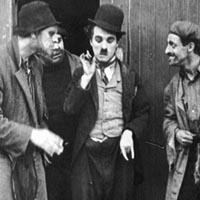The Tramp

The Tramp is enjoyable as a first “official” look at what became Chaplin’s iconic character, but don’t read too much into it. As Chaplin scholars have pointed out, it was just another “role” for Chaplin to play, as he had played and would play a bakery worker, bank clerk, etc., before and after this movie.
What is historic, of a sort, in this movie is how Chaplin tries to blend comedy and pathos. The effort failed, but it probably stood out as an aberration more in 1915 than it does now. Here, we can almost look at it as almost a “blooper” or a character defect, especially knowing how, in retrospect, Chaplin would eventually get it right.
In the title role, Chaplin plays a loner tramp on the road who happens to save a country girl (Edna Purviance) from being robbed from a trio of tramps from the woods. As a result, Edna introduces Charlie to her father, who gives him a job on their farm. (Charlie’s not completely virtuous; he pretty much fobs the job off on an already-hired hand.)
When Charlie again saves Edna and her dad from the three tramps and then gives chase to them, he is shot in the leg. Edna nurses Charlie back to health, which Charlie is more than willing to let her do. Then a man arrives from the city, and Charlie discovers it’s Edna’s boyfriend. Teary-eyed, Charlie writes a good-bye note (see "Editing Note" below) and then leaves the farm for good, finally lifting his head, shrugging off his fate, and skedaddling down the road, in one of cinema’s most iconic finales.
Chaplin was obviously starting to yearn for more than just laughs, but he hadn’t come upon the right formula yet. In the meantime, the laughs would hold him over.
Editing Note: Just before the final shot of Charlie walking down the open road, there's a shot of Edna and her family reading Charlie's good-bye letter. I have seen prints of The Tramp that both do and do not show the text of Charlie's letter. In the prints where the letter is shown, it reads (including misspellings): "I thort your kindness was love but it aint cause I seen him. Goodbye." This strikes me as exactly the kind of maudlin emotion that Chaplin wouldn't want to include; the prints without this note get Chaplin's message across just as well. Is this yet another example of Essanay's tampering with Chaplin's work after the fact?
Click here to return to:
HomepageFilmography